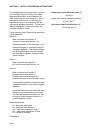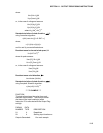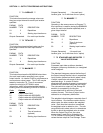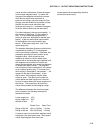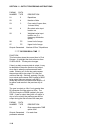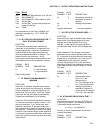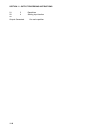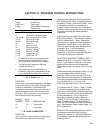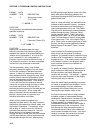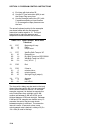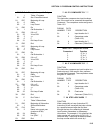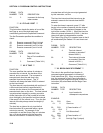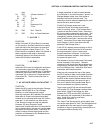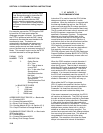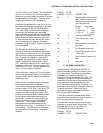SECTION 12. PROGRAM CONTROL INSTRUCTIONS
12-2
PARAM. DATA
NUMBER TYPE DESCRIPTION
01: 2 Subroutine number
(1-9, 79-99)
*** 86 DO ***
FUNCTION
This Instruction unconditionally executes the
specified command.
PARAM. DATA
NUMBER TYPE DESCRIPTION
01: 2 Command (Table 12-2)
*** 87 LOOP ***
FUNCTION
Instructions included between the Loop
Instruction and the End Instruction (95) are
repeated the number of times specified by the
iteration count (Parameter 2), or until an Exit
Loop command (31,32) is executed by a
Program Control Instruction within the Loop. If
0 is entered for the count, the loop is repeated
until an Exit Loop command is executed.
The first parameter, delay, controls how
frequently passes through the loop are made.
Its units are multiples of the table execution
interval. A delay of 0 means that there is no
delay between passes through the loop. Each
time the table is executed all iterations of the
loop will be completed and execution will pass
on to the following instructions. If the delay is
5, every fifth time that the execution interval
comes up, one pass through the loop is made;
only those instructions in the loop will be
executed and other portions of the table are not
executed in the interim. When a loop with
delay is executed, the next execution starts at
the loop, skipping over any previous and
following instructions in the table.
When a fixed number of iterations are
executed, the time spent in the loop is equal to
the product of the execution interval, delay, and
the number of iterations. For example, a loop
with a delay of 1 and a count of 5 will take 5
seconds if the execution interval is 1 second.
When the loop is first entered, one pass
through the loop is made, then the CR10 delays
until the next execution interval and makes the
second pass through the loop. After making
the fifth pass through the loop, there is the fifth
delay, after which execution passes to the
instruction following the END instruction which
goes with the loop.
While in a loop with delay, the table will not be
initiated at each execution interval. (However,
the overrun decimals will not be displayed.)
Some consequences of this are: The Output
Flag will not be automatically cleared between
passes through the loop. Because Table 2
cannot interrupt Table 1, Table 2 will not be
executed while Table 1 is in a loop with delay.
Table 1 will not interrupt Table 2 in the middle
of an output array. Thus, if the Output Flag is
set in Table 2 prior to entering the loop or within
the loop, the flag must be specifically cleared
before the end of the pass if Table 1 is to be
executed.
Input locations for Processing Instructions
within a loop can be entered as Indexed
locations. An Indexed location causes the input
location to be incremented by 1 with each pass
through the loop. (The Index counter is added
to the location number in the program table.)
Input locations which are not indexed will
remain constant.
To specify an Indexed location, depress the C
key at some point while keying in the digits for
the input location and before entering the
location with the A key. Two dashes, --, appear
in the two right most characters of the display,
indicating the entry is Indexed.
When the same output processing is required
on values in sequential input locations, it must
be accomplished by using the repetitions
parameter of the Output Instruction, not by
indexing the input location within a loop.
An Output Instruction within a loop is allotted
the same number of Intermediate Storage
locations as it would receive if it were not in the
loop. For example, the average instruction with
a single repetition is allotted only two
Intermediate locations: one for the number of
samples and one for the running total. Each
time through the loop the sample counter is
incremented and the value in the referenced
input location is added to the total. If the input
location is indexed, the values from all input
locations are added to the same total.



